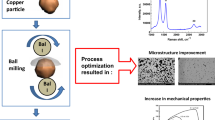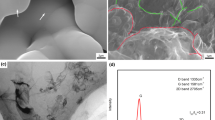Abstract
Graphene-reinforced copper composites have gained significant attention due to their exceptional properties and potential applications across various industries. This study presents a novel approach to synthesize 3D graphene–copper heterostructures using a plasma-enhanced chemical vapor deposition (PECVD) technique. The method involves encapsulating Cu powders with graphitic layers through PECVD at a low temperature of 400 °C to prevent copper powder agglomeration during the process, ensuring uniform graphene coating across the entire copper surface. Microstructural characterization of the resulting 3D graphene–copper heterostructures confirms successful encapsulation, with graphitic coating thicknesses ranging from 5–15 nm. The unique graphene-encapsulated Cu powder structure facilitates pressureless sintering, yielding consolidated composites with exceptional structural integrity. Metallographic analysis of the consolidated samples revealed a uniformly distributed multilayer graphitic network within the graphene–copper (G/Cu) composite structure. The presence of graphene between copper grains is found to inhibit copper grain growth, leading to smaller copper grains compared to graphene-free copper monoliths. Furthermore, the G/Cu composite had significantly reduced pore size and ensuant higher density when compared to the sample prepared without graphene encapsulation. Graphene’s lubricating effect is presumed to enhance the freedom of rotation for copper grains during sintering and cause increased densification. The thermal diffusivity of the graphene–copper heterostructure is measured as 1.38 cm2/s using thermal flash technique, representing an approximate 40% improvement compared to graphene-free copper. This enhancement in thermal conductivity is attributed to the presence of strongly bonded graphene layers between copper grains and additional thermal transport originating from graphitic interface. Thermal diffusivity was decreased monotonically with increasing temperature at temperature range 20–200 °C indicating prevalent phonon contribution. In the context of technological implications, successful synthesis of 3D graphene–copper heterostructures using scalable plasma-enhanced chemical vapor deposition (PECVD) technique establishes a foundation for the development of advanced materials with tailored properties and multifunctional applications, particularly those requiring lightweight characteristics, high transport properties (thermal or electrical), and exceptional mechanical strength.




Similar content being viewed by others
Data availability
Not Applicable.
References
Chen Y et al (2016) Fabrication of three-dimensional graphene/Cu composites by in situ CVD and its strengthening mechanism. J Alloys Compd 688:69–76
Chu K et al (2018) Thermal properties of graphene/metal composites with aligned graphene. Mater Des 140:85–94
Chu K, Jia C (2014) Enhanced strength in bulk graphene–copper composites. Phys Status Solidi A 211:184–190
Jagannadham K (2012) Electrical conductivity of copper–graphene composite films synthesized by electrochemical deposition with exfoliated graphene platelets. J Vac Sci Technol B. https://doi.org/10.1116/1.3701701
Jagannadham K (2012) Thermal conductivity of copper–graphene composite films synthesized by electrochemical deposition with exfoliated graphene platelets. Met Mater Trans B 43:316–324
Kim Y et al (2013) Strengthening effect of single-atomic-layer graphene in metal-graphene nanolayered composites. Nat Commun 4:2114
Li MX, Xie J, Li YD, Xu HH (2015) Reduced graphene oxide dispersed in copper matrix composites: facile preparation and enhanced mechanical properties. Phys Status Solidi A 212:2154–2161
Li W, Li D, Fu Q, Pan C (2015) Conductive enhancement of copper/graphene composites based on high-quality graphene. RSC Adv 5:80428–80433
Liu X, Wei D, Zhuang L, Cai C, Zhao Y (2015) Fabrication of high-strength graphene nanosheets/Cu composites by accumulative roll bonding. Mater Sci Eng A 642:1–6
Saboori A, Pavese M, Badini C, Fino PA (2018) novel approach to enhance the mechanical strength and electrical and thermal conductivity of Cu–GNP nanocomposites. Met Mater Trans A 49:333–345
Varol T, Canakci A (2015) Microstructure, electrical conductivity and hardness of multilayer graphene/copper nanocomposites synthesized by flake powder metallurgy. Met Mater Int 21:704–712
Wang X, Li J, Wang Y (2016) Improved high temperature strength of copper–graphene composite material. Mater Lett 181:309–312
Zhang D, Zhan Z (2016) Strengthening effect of graphene derivatives in Cu matrix composites. J Alloys Compd 654:226–233
Goli P et al (2014) Thermal properties of graphene–copper–graphene heterogeneous films. Nano Lett 14:1497–1503
Gao X et al (2016) Mechanical properties and thermal conductivity of graphene reinforced copper matrix composites. Powder Technol 301:601–607
Chu K et al (2018) Largely enhanced thermal conductivity of graphene/copper composites with highly aligned graphene network. Carbon 127:102–112
Hsieh CC, Liu WR (2017) Synthesis and characterization of nitrogen-doped graphene nanosheets/copper composite film for thermal dissipation. Carbon 118:1–7
Xie G, Forslund M, Pan J (2014) Direct electrochemical synthesis of reduced graphene oxide (rGO)/copper composite films and their electrical/electroactive properties. Appl Mater Interfaces 6:7444–7455
Cao M et al (2017) Aligning graphene in bulk copper: Nacre-inspired nanolaminated architecture coupled with in situ processing for enhanced mechanical properties and high electrical conductivity. Carbon 117:65–74
Maharana HS, Rai PK, Basu A (2017) Suface-mechanical and electrical properties of pulse electrodeposited Cu–graphene oxide composite coating for electrical contacts. J Mater Sci 52:1089–1105
Cui Y, Wang L, Li B, Cao G, Fei W (2014) Effect of ball-milling on the defeat of few-layer graphene and properties of copper matrix composites. Acta Met Sin Engl Lett 27:937–943
Dutkiewicz J et al (2015) Microstructure and properties of bulk copper matrix composites strengthened with various kinds of graphene nanoplatelets. Mater Sci Eng A 628:124–134
Yue H et al (2017) Effect of ball-milling and graphene contents on the mechanical properties and fracture mechanisms of graphene nanosheets reinforced copper matrix composites. J Alloys Compd 691:755–762
Dong L, Chen W, Zheng C, Deng N (2017) Microstructure and properties characterization of tungsten-copper composite materials doped with graphene. J Alloys Compd 695:1637–1646
Li M, Che H, Liu X, Liang S, Xie H (2014) Highly enhanced mechanical properties in Cu matrix composites reinforced with graphene decorated metallic nanoparticles. J Mater Sci 49:3725–3731
Zhao C, Wang J (2014) Fabrication and tensile properties of graphene/copper composites prepared by electroless plating for structural applications. Phys Status Solidi A 211:2878–2885
Wang L et al (2015) High apparent strengthening efficiency for reduced graphene oxide in copper matrix composites produced by molecule-lever mixing and high shear mixing. RSC Adv 5:51193–51200
Jiang R, Zhou X, Fang Q, Liu Z (2016) Copper–graphene bulk composites with homogeneous graphene dispersion and enhanced mechanical properties. Mater Sci Eng A 654:124–130
Zhang X et al (2016) Facile synthesis and characterization of reduced graphene oxide/copper composites using freeze–drying and spark plasma sintering. Mater Lett 166:67–70
Chu K, Wang F, Wang XH, Huang DJ (2018) Anisotropic mechanical properties of graphene/copper composites with aligned graphene. Mater Sci Eng A 713:269–277
Tang Y, Yang X, Wang R, Li M (2014) Enhancement of the mechanical properties of graphene–copper composites with graphene-nickel hybrids. Mater Sci Eng A 599:247–254
Ahmad SNAS, Hashim J, Ghazali MI (2007) Effect of porosity on tensile properties of cast particle reinforced MMC. J Compos Mater 41:575–589
Levchenko I et al (2016) Scalable graphene production: perspectives and challenges of plasma applications. Nanoscale 8:10511–10527
Xiao Q et al (2017) In-situ synthesis of graphene on surface of copper powder by rotary CVD and its application in fabrication of reinforced Cu-matrix composites. Adv Mater Sci 2:1–6
Yang M, Sasaki S, Ohnishi M, Suzuki K, Miura H (2016) Electronic properties and strain sensitivity of CVD-grown graphene with acetylene. Jpn J Appl Phys 55:04EP05
Wang S et al (2012) Synthesis, growth mechanism and thermal stability of copper nanoparticles encapsulated by multi-layer graphene. Carbon 50:2119–2125
Zhang Q et al (2018) Self-assembly of graphene-encapsulated Cu composites for nonenzymatic glucose sensing. ACS Omega 3:3420–3428
Li T, Wang Y, Yang M, Hou H, Wu S (2021) High strength and conductivity copper/graphene composites prepared by severe plastic deformation of graphene coated copper powder. Mater Sci Eng A 826:141983
Hwang J et al (2013) Enhanced mechanical properties of graphene copper nanocomposites using a molecular-level mixing process. Adv Mater 25:6724–6729
Zhang D, Zhan Z (2016) Preparation of graphene nanoplatelets-copper composites by a modified semi-powder method and their mechanical properties. J Alloys Compd 658:663–6715
Song G, Fu Q, Pan C (2018) Copper–graphene composite foils via electro-deposition: a mini review. MRS Adv 3:37–44
Wang M et al (2019) Direct synthesis of high-quality graphene on Cu powders from adsorption of small aromatic hydrocarbons: a route to high strength and electrical conductivity for graphene/Cu composite. J Alloys Compd 798:403–413
Konakov VG, Kurapova OYu, Archakov IYu (2020) Improvement of copper–graphene composites properties due to the lubricating effect of graphene in the powder metallurgy fabrication process. Met Mater Int 26:1899–1907
Balandin AA et al (2008) Superior thermal conductivity of single-layer graphene. Nano Lett 8:902–907
Chen S et al (2011) Raman measurements of thermal transport in suspended monolayer graphene of variable sizes in vacuum and gaseous environments. ACS Nano 5:321–328
Acknowledgements
The authors gratefully acknowledge the support provided by The Scientific and Technological Research Council of Turkey (TUBITAK) under award number 118F491. The authors express their gratitude to Prof. Dr. Benat Kockar and Ogulcan Akgul for their invaluable support in sample pressing, sintering, and metallographic preparation.
Author information
Authors and Affiliations
Contributions
GB, OC, and DC conceptualized the experimental design. DC and OC conducted the experiments, performed measurements, and gathered data. All authors contributed to data analysis, result interpretation, and manuscript writing.
Corresponding author
Ethics declarations
Conflict of interest
The authors declare that there are no conflicts of interest or competing interests that could potentially influence or bias the submitted work.
Ethical approval
Not Applicable.
Additional information
Handling Editor: N. Ravishankar.
Publisher's Note
Springer Nature remains neutral with regard to jurisdictional claims in published maps and institutional affiliations.
Rights and permissions
Springer Nature or its licensor (e.g. a society or other partner) holds exclusive rights to this article under a publishing agreement with the author(s) or other rightsholder(s); author self-archiving of the accepted manuscript version of this article is solely governed by the terms of such publishing agreement and applicable law.
About this article
Cite this article
Cakir, D., Caylan, O.R. & Cambaz Buke, G. Synthesis and characterization of homogeneously dispersed graphene–copper heterostructures with enhanced thermal properties. J Mater Sci 59, 105–113 (2024). https://doi.org/10.1007/s10853-023-09188-7
Received:
Accepted:
Published:
Issue Date:
DOI: https://doi.org/10.1007/s10853-023-09188-7




